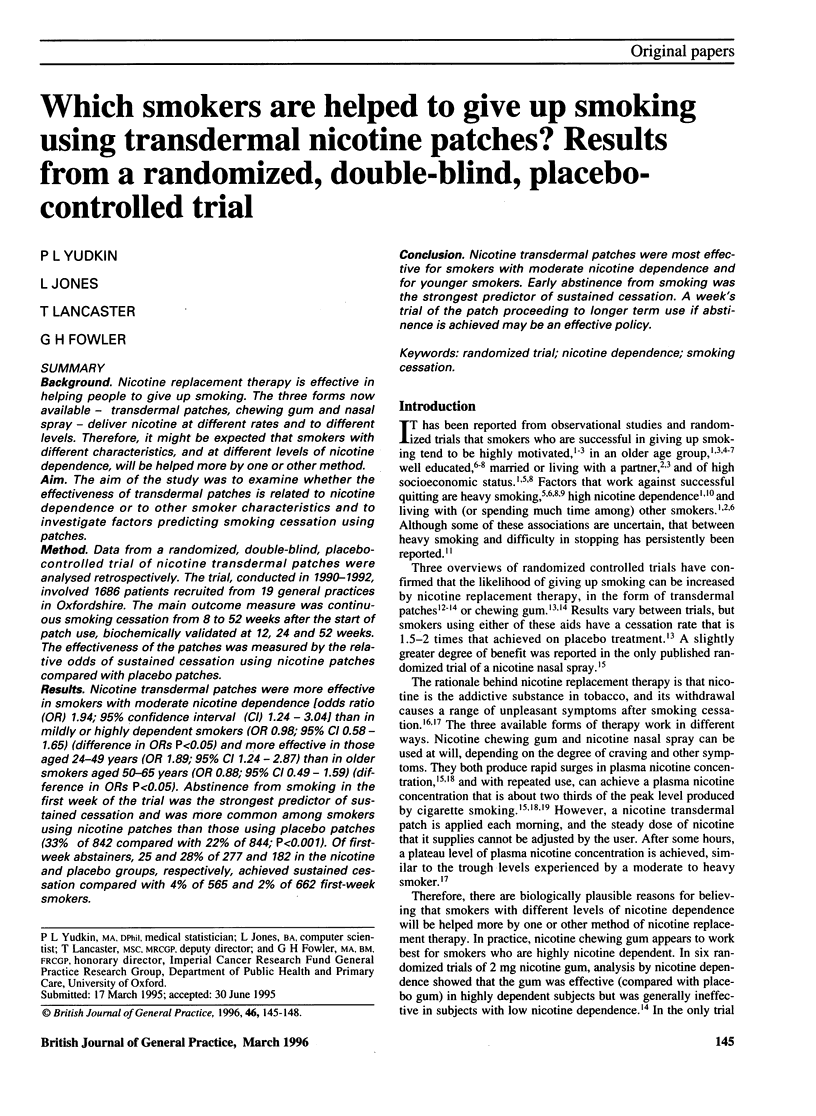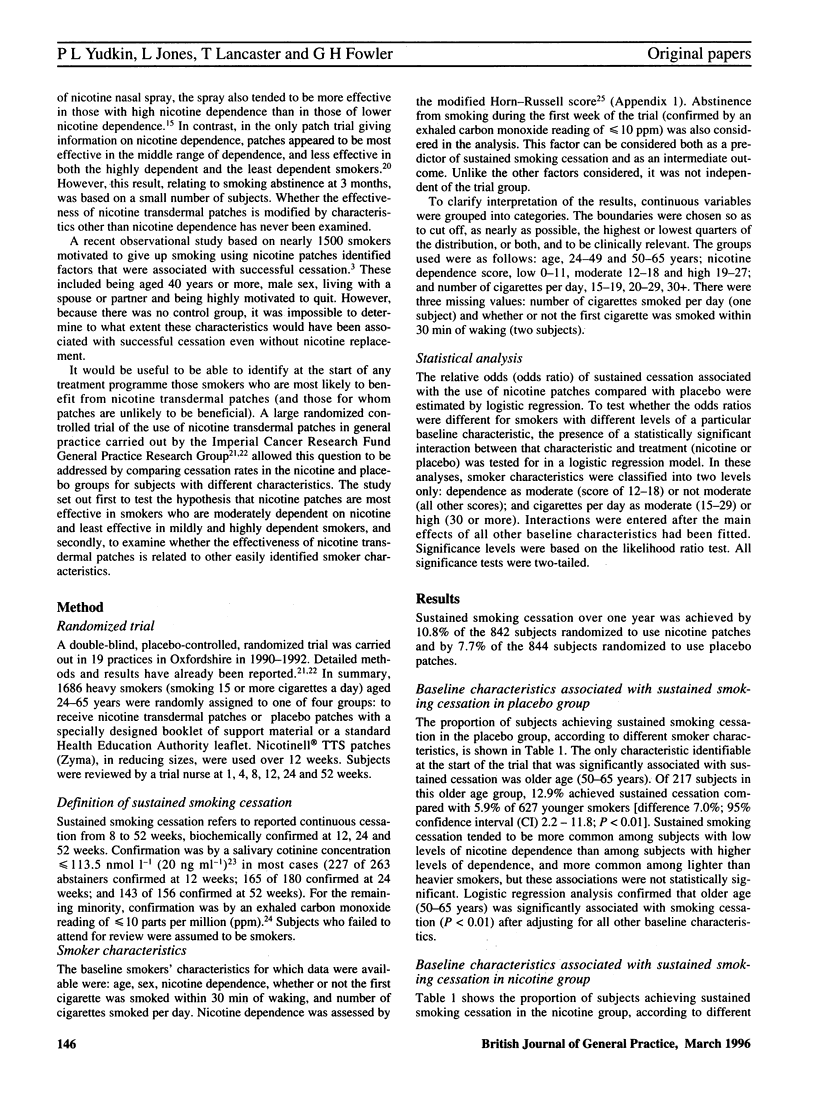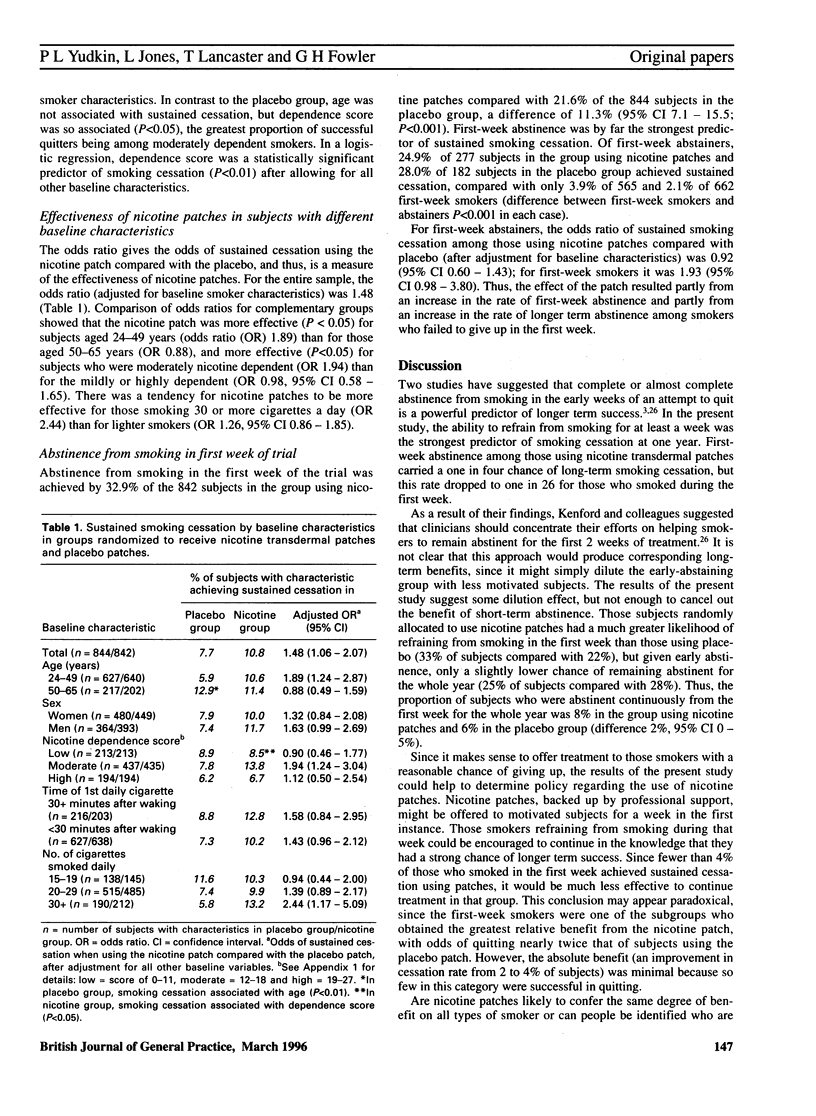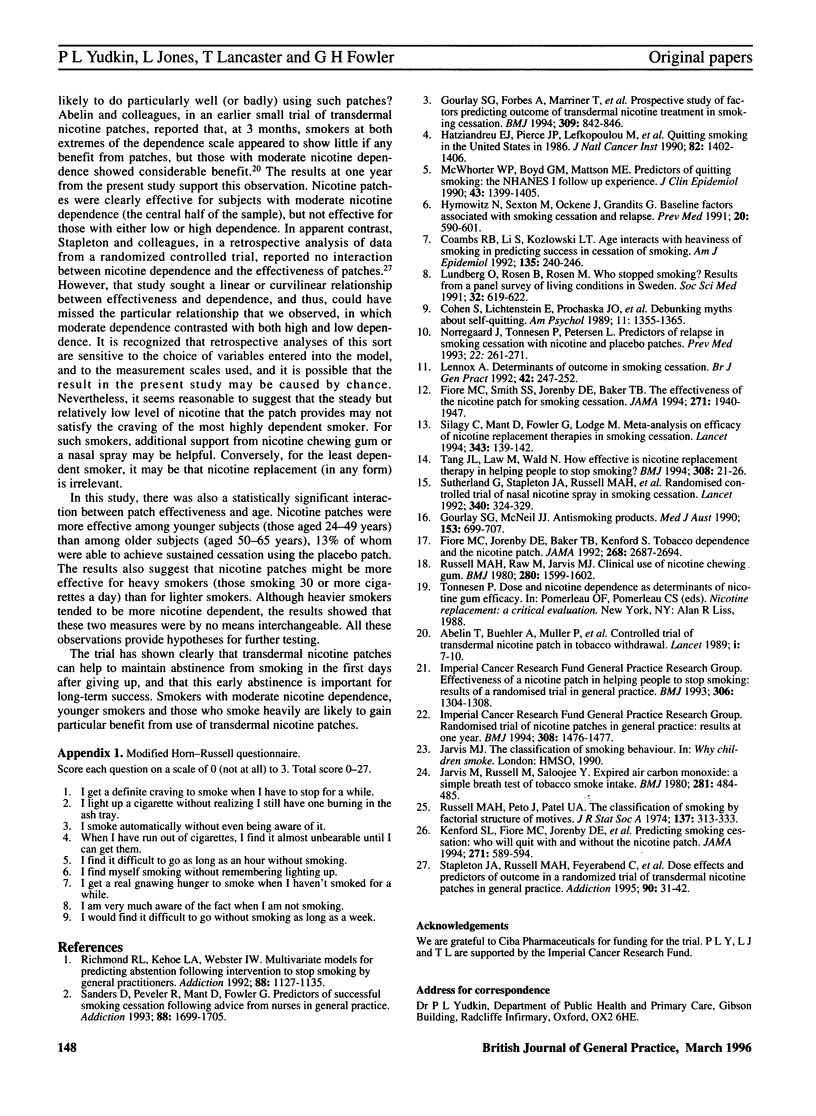Abstract
BACKGROUND: Nicotine replacement therapy is effective in helping people to give up smoking. The three forms now available--transdermal patches, chewing gum and nasal spray--deliver nicotine at different rates and to different levels. Therefore, it might be expected that smokers with different characteristics, and at different levels of nicotine dependence, will be helped more by one or other method. AIM: The aim of the study was to examine whether the effectiveness of transdermal patches is related to nicotine dependence or to other smoker characteristics and to investigate factors predicting smoking cessation using patches. METHOD: Data from a randomized, double-blind, placebo-controlled trial of nicotine transdermal patches were analysed retrospectively. The trial, conducted in 1990-1992, involved 1686 patients recruited from 19 general practices in Oxfordshire. The main outcome measure was continuous smoking cessation from 8 to 52 weeks after the start of patch use, biochemically validated at 12, 24 and 52 weeks. The effectiveness of the patches was measured by the relative odds of sustained cessation using nicotine patches compared with placebo patches. RESULTS: Nicotine transdermal patches were more effective in smokers with moderate nicotine dependence [odds ratio (OR) 1.94; 95% confidence interval (CI) 1.24-3.04] than in mildly or highly dependent smokers (OR 0.98; 95% CI 0.58-1.65) (difference in ORs P < 0.05) and more effective in those aged 24-49 years (OR 1.89; 95% CI 1.24-2.87) than in older smokers aged 50-65 years (OR 0.88; 95% CI 0.49-1.59) (difference in ORs P < 0.05). Abstinence from smoking in the first week of the trial was the strongest predictor of sustained cessation and was more common among smokers using nicotine patches than those using placebo patches (33% of 842 compared with 22% of 844; P < 0.001). Of first-week abstainers, 25 and 28% of 277 and 182 in the nicotine and placebo groups, respectively, achieved sustained cessation compared with 4% of 565 and 2% of 662 first-week smokers. CONCLUSION: Nicotine transdermal patches were most effective for smokers with moderate nicotine dependence and for younger smokers. Early abstinence from smoking was the strongest predictor of sustained cessation. A week's trial of the patch proceeding to longer term use if abstinence is achieved may be an effective policy.
Full text
PDF



Selected References
These references are in PubMed. This may not be the complete list of references from this article.
- Abelin T., Buehler A., Müller P., Vesanen K., Imhof P. R. Controlled trial of transdermal nicotine patch in tobacco withdrawal. Lancet. 1989 Jan 7;1(8628):7–10. doi: 10.1016/s0140-6736(89)91671-1. [DOI] [PubMed] [Google Scholar]
- Coambs R. B., Li S., Kozlowski L. T. Age interacts with heaviness of smoking in predicting success in cessation of smoking. Am J Epidemiol. 1992 Feb 1;135(3):240–246. doi: 10.1093/oxfordjournals.aje.a116277. [DOI] [PubMed] [Google Scholar]
- Cohen S., Lichtenstein E., Prochaska J. O., Rossi J. S., Gritz E. R., Carr C. R., Orleans C. T., Schoenbach V. J., Biener L., Abrams D. Debunking myths about self-quitting. Evidence from 10 prospective studies of persons who attempt to quit smoking by themselves. Am Psychol. 1989 Nov;44(11):1355–1365. doi: 10.1037//0003-066x.44.11.1355. [DOI] [PubMed] [Google Scholar]
- Fiore M. C., Jorenby D. E., Baker T. B., Kenford S. L. Tobacco dependence and the nicotine patch. Clinical guidelines for effective use. JAMA. 1992 Nov 18;268(19):2687–2694. [PubMed] [Google Scholar]
- Fiore M. C., Smith S. S., Jorenby D. E., Baker T. B. The effectiveness of the nicotine patch for smoking cessation. A meta-analysis. JAMA. 1994 Jun 22;271(24):1940–1947. [PubMed] [Google Scholar]
- Gourlay S. G., Forbes A., Marriner T., Pethica D., McNeil J. J. Prospective study of factors predicting outcome of transdermal nicotine treatment in smoking cessation. BMJ. 1994 Oct 1;309(6958):842–846. doi: 10.1136/bmj.309.6958.842. [DOI] [PMC free article] [PubMed] [Google Scholar]
- Gourlay S. G., McNeil J. J. Antismoking products. Med J Aust. 1990 Dec 3;153(11-12):699–707. doi: 10.5694/j.1326-5377.1990.tb126327.x. [DOI] [PubMed] [Google Scholar]
- Hatziandreu E. J., Pierce J. P., Lefkopoulou M., Fiore M. C., Mills S. L., Novotny T. E., Giovino G. A., Davis R. M. Quitting smoking in the United States in 1986. J Natl Cancer Inst. 1990 Sep 5;82(17):1402–1406. doi: 10.1093/jnci/82.17.1402. [DOI] [PubMed] [Google Scholar]
- Jarvis M. J., Russell M. A., Saloojee Y. Expired air carbon monoxide: a simple breath test of tobacco smoke intake. Br Med J. 1980 Aug 16;281(6238):484–485. doi: 10.1136/bmj.281.6238.484. [DOI] [PMC free article] [PubMed] [Google Scholar]
- Kenford S. L., Fiore M. C., Jorenby D. E., Smith S. S., Wetter D., Baker T. B. Predicting smoking cessation. Who will quit with and without the nicotine patch. JAMA. 1994 Feb 23;271(8):589–594. doi: 10.1001/jama.271.8.589. [DOI] [PubMed] [Google Scholar]
- Lennox A. S. Determinants of outcome in smoking cessation. Br J Gen Pract. 1992 Jun;42(359):247–252. [PMC free article] [PubMed] [Google Scholar]
- Lundberg O., Rosén B., Rosén M. Who stopped smoking? Results from a panel survey of living conditions in Sweden. Soc Sci Med. 1991;32(5):619–622. doi: 10.1016/0277-9536(91)90297-p. [DOI] [PubMed] [Google Scholar]
- McWhorter W. P., Boyd G. M., Mattson M. E. Predictors of quitting smoking: the NHANES I followup experience. J Clin Epidemiol. 1990;43(12):1399–1405. doi: 10.1016/0895-4356(90)90108-2. [DOI] [PubMed] [Google Scholar]
- Nørregaard J., Tønnesen P., Petersen L. Predictors and reasons for relapse in smoking cessation with nicotine and placebo patches. Prev Med. 1993 Mar;22(2):261–271. doi: 10.1006/pmed.1993.1021. [DOI] [PubMed] [Google Scholar]
- Richmond R. L., Kehoe L. A., Webster I. W. Multivariate models for predicting abstention following intervention to stop smoking by general practitioners. Addiction. 1993 Aug;88(8):1127–1135. doi: 10.1111/j.1360-0443.1993.tb02132.x. [DOI] [PubMed] [Google Scholar]
- Russell M. A., Raw M., Jarvis M. J. Clinical use of nicotine chewing-gum. Br Med J. 1980 Jun 28;280(6231):1599–1602. doi: 10.1136/bmj.280.6231.1599. [DOI] [PMC free article] [PubMed] [Google Scholar]
- Sanders D., Peveler R., Mant D., Fowler G. Predictors of successful smoking cessation following advice from nurses in general practice. Addiction. 1993 Dec;88(12):1699–1705. doi: 10.1111/j.1360-0443.1993.tb02045.x. [DOI] [PubMed] [Google Scholar]
- Silagy C., Mant D., Fowler G., Lodge M. Meta-analysis on efficacy of nicotine replacement therapies in smoking cessation. Lancet. 1994 Jan 15;343(8890):139–142. doi: 10.1016/s0140-6736(94)90933-4. [DOI] [PubMed] [Google Scholar]
- Stapleton J. A., Russell M. A., Feyerabend C., Wiseman S. M., Gustavsson G., Sawe U., Wiseman D. Dose effects and predictors of outcome in a randomized trial of transdermal nicotine patches in general practice. Addiction. 1995 Jan;90(1):31–42. doi: 10.1046/j.1360-0443.1995.901316.x. [DOI] [PubMed] [Google Scholar]
- Sutherland G., Stapleton J. A., Russell M. A., Jarvis M. J., Hajek P., Belcher M., Feyerabend C. Randomised controlled trial of nasal nicotine spray in smoking cessation. Lancet. 1992 Aug 8;340(8815):324–329. doi: 10.1016/0140-6736(92)91403-u. [DOI] [PubMed] [Google Scholar]
- Tang J. L., Law M., Wald N. How effective is nicotine replacement therapy in helping people to stop smoking? BMJ. 1994 Jan 1;308(6920):21–26. doi: 10.1136/bmj.308.6920.21. [DOI] [PMC free article] [PubMed] [Google Scholar]


